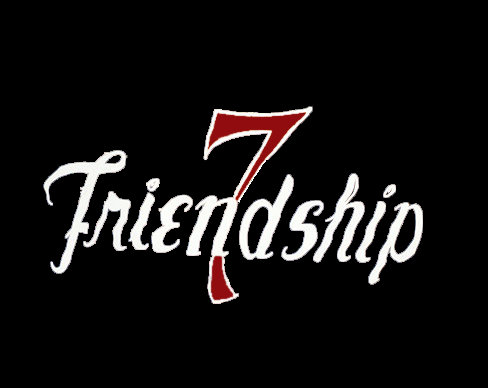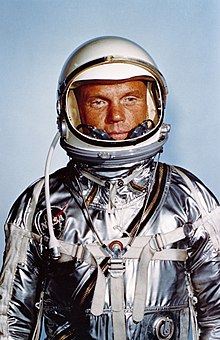Friendship 7

Still frame of John Glenn in orbit, taken by a motion picture camera inside Friendship 7
|
|||||
| Mission type | Test flight | ||||
|---|---|---|---|---|---|
| Operator | NASA | ||||
| Harvard designation | 1962 Gamma 1 | ||||
| SATCAT № | 240 | ||||
| Mission duration | 4 hours, 55 minutes, 23 seconds | ||||
| Distance travelled | 121,794 kilometers (65,763 nautical miles) | ||||
| Orbits completed | 3 | ||||
| Spacecraft properties | |||||
| Spacecraft | Mercury No.13 | ||||
| Manufacturer | McDonnell Aircraft | ||||
| Launch mass | 1,352 kilograms (2,981 lb) | ||||
| Crew | |||||
| Crew size | 1 | ||||
| Members | John H. Glenn, Jr | ||||
| Callsign | Friendship 7 | ||||
| Start of mission | |||||
| Launch date | February 20, 1962, 14:47:39 UTC | ||||
| Rocket | Atlas LV-3B 109-D | ||||
| Launch site | Cape Canaveral LC-14 | ||||
| End of mission | |||||
| Recovered by | USS Noa | ||||
| Landing date | February 20, 1962, 19:43:02 UTC | ||||
| Landing site | North Atlantic Ocean 21°20′N 68°40′W / 21.333°N 68.667°W |
||||
| Orbital parameters | |||||
| Reference system | Geocentric | ||||
| Regime | Low Earth orbit | ||||
| Perigee | 149 kilometers (80 nautical miles) | ||||
| Apogee | 248 kilometers (134 nautical miles) | ||||
| Inclination | 32.5 degrees | ||||
| Period | 88.47 minutes | ||||
| Epoch | February 20, 1962 | ||||
|
|||||
Mercury-Atlas 6 (MA-6) was the third human spaceflight for the U.S. and part of Project Mercury. Conducted by NASA on February 20, 1962, the mission was piloted by astronaut John Glenn, who performed three orbits of the Earth, making him the first U.S. astronaut to orbit the Earth.
The Mercury spacecraft, named Friendship 7, was carried to orbit by an Atlas LV-3B launch vehicle lifting off from Launch Complex 14 at Cape Canaveral, Florida. After four hours and 56 minutes in flight the spacecraft re-entered the Earth's atmosphere, splashed down in the North Atlantic Ocean and was safely taken aboard USS Noa.
The event was named an IEEE Milestone in 2011.
After the successful completion of the Mercury 5 flight that carried Enos, a chimpanzee, in late November 1961, a press conference was held in early December. Reporters asked NASA's Robert Gilruth who would be the first U.S. astronaut in orbit, piloting Mercury 6. He then announced the team members for the next two Mercury missions. John H. Glenn was selected as prime pilot for the first mission (Mercury 6), with M. Scott Carpenter as his backup. Donald K. Slayton and Walter M. Schirra were pilot and backup, respectively, for the second mission, Mercury 7.
...
Wikipedia


